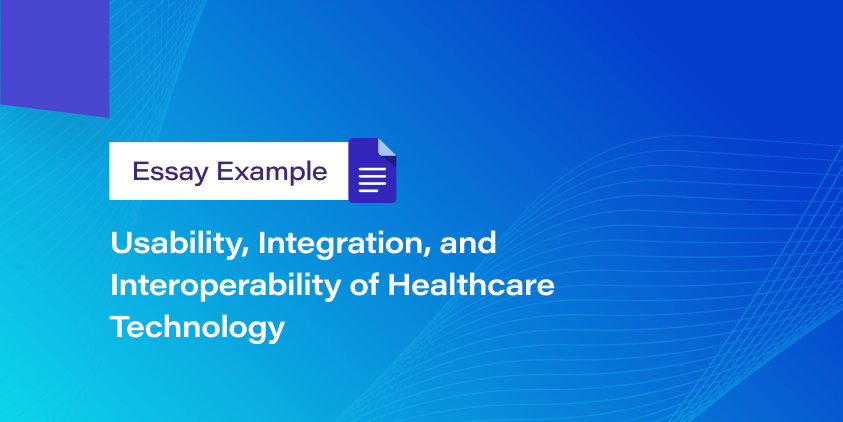Usability, Integration, and Interoperability of Healthcare Technology

Healthcare has embraced the use of the latest technology. In the beginning, medical practitioners faced many challenges. Over time, health informatics has improved and made system operations easier. Usability, integration, and interoperability of healthcare technology aim at examining various ways in which the application of technology has contributed to the provision of medical services. Usability refers to the ease of software use. Technology is now developing software that is faster and better in its operation. Integration relates to employing information technology to deliver primary healthcare and manage patients’ information. Thus, integration involves appropriate and innovative technology in different departments. Interoperability is the interaction between separate databases, programs and multiple devices in an organization that leads to enhanced management of data and communication. Besides, interoperability allows information sharing between nurses, vendors, clinicians and pharmacists without issuing a command to send the data. Therefore, healthcare technology’s usability, integration and interoperability make it easy to start using a system, help to save time and reduce errors, and provide for sharing and interpretation of information without any alteration.
Examples of Usability, Integration, and Interoperability
Usability
Usability is the ease of the system’s use. Initially, medics found EHR to be complicated and hard to apply. Training and elaboration enabled many physicians to know how to deal with the system. However, it still has some complications and needs adjustments to make the interface user-friendly. The system has greatly developed since its introduction.
Nevertheless, training some clinicians on using all new technology in healthcare is possible. A manual system that is easy to operate helps medical workers to adapt quickly to the latest technology. Healthcare should resort to a language that is understandable by every healthcare provider. Any technical terms should be explained before the installation of the system.
An example of usability is the improved use of the EHR system. Initially, the clinician was required to log into the system by entering a password. The next step, such as accessing the patient’s information, demanded plenty of scrolling and clicking. The procedure could have been more efficient and cost medical workers a lot of time. Physicians no longer need to type login details and scroll a lot. Healthcare uses face and voice recognition, iris and retina to identify staff members and allow the system to be easily operated. The technology ensures that only authorized individuals have access to specific information. Biometric identification provides better patient information access and protects privacy. The caregiver uses fingerprints to obtain the patient’s records in this technique. As a result, this technology reduces the chances of medical error since data are revealed only to the patient personally.
Moreover, it eliminates the possibility of forgetting the login password for each patient, which was initially aimed at maintaining privacy. The system has also developed shortcuts allowing clinicians to easily access an interface. Healthcare providers work under time pressure and are required to do several things at the same time. A system that helps to minimize the amount of information to be remembered is easy to be applied in healthcare; additionally, it saves time, making the caregiving process more comfortable and ensuring timely intervention.
Integration
Integration is the constant updating of the system to accommodate evolving technology. Government and insurance policies keep changing. Hence, ongoing development of treatment routines is necessary to enhance the patient’s safety and health outcome. Besides, the patient’s health condition may improve or worsen over time. Healthcare should continue integrating the changes into its system. Using older methods will lead to legal actions and poor health outcomes. An integrated EHR enables the quick sharing and transfer of information. It also makes it easier to examine, diagnose and treat diseases. Furthermore, the administrative role also benefits as the administrator has all the essential information at his or her disposal. Every year, the government and hospitals spend significant money to integrate and promote the system.
An example of integration is wireless access to patients’ information. The technology eliminates the use of wires and cables to transfer data. Healthcare facilities use wireless Internet to pass information from the patient room to the department. The caregiver is no longer constrained in a centralized data station. He/she can move around and still access the patient’s information. The technology also provides an instant update on patients’ health conditions.
Moreover, healthcare centers combine wireless access with telehealth technology that enables patient health information transfer from the unit to the physician. Telehealth incorporates devices measuring blood sugar and pressure, heartbeat, temperature, and other health measures. Hence, the technology allows the physician to attend to the patient without visiting their room. The nurse instantly receives instructions from the doctor due to the wireless access and administers the prescribed care.
Interoperability
Semantic interoperability is the most efficient system, ensuring transfer, interpretation and response to the information. It enables the passage of data to various programs and systems without losing or altering any data field. Medics use this interoperability to improve patient care, safety and quality of services. Loss of data and reduced interpretation may lead to wrong diagnosis and inadequate treatment, thus risking the patient’s life. Hospitals have invested in semantic interoperability because it is comprehensive, although the initial installation cost is rather high. However, the system is only sometimes universal across the country. Therefore, there are still difficulties when transferring patient information from one healthcare facility to another. The information may only be utilized if the systems are compatible. It requires the healthcare setting that receives the data to enter it manually into their system, giving room for alteration and wasting time. Consequently, the government should help to install an interoperable system that will transfer data from one institution to another without modifications.
Personal Experience
When the use of EHR started, I noticed clinicians still resorted to patient notes. The system was first improved by having a second person to take notes, which interfered with privacy. Nowadays, healthcare is increasing usability using voice recognition typing software. Patients were concerned about privacy issues claiming that anyone could access their health records as long as they had the system login details. The healthcare facility adopted biometric identification to ensure the patient permits access. Interoperability problems I have experienced involved sharing patient information between healthcare institutions.
In some cases, the process took longer than expected and in other instances, the healthcare systems needed to be compatible, making it easier to use the information. Personal health record technology ensures that every patient has universal data. The government should ensure uniformity in the EHR system utilized in every medical center to enhance the information-sharing process.
Conclusion
Usability, integration and interoperability of healthcare technology make it easy to implement a system, help to save time, decrease the probability of errors, and allow sharing and interpretation of information without alterations. Usability is the ease of the system’s use. Medical practitioners prefer an understandable system that requires fewer steps before actual application. The introduction of biometric identification has improved EH.R’s usability. It has reduced the menace of remembering login details and excessive scrolling. Integration aims at adopting the latest technology, such as telehealth and wireless access, which contribute to better delivery of healthcare services. Semantic interoperability makes it easier for medical workers to share, access and interpret patient information. Therefore, the government, in collaboration with hospitals, should invest more in user-friendly technology.
📎 References
1. Adenuga, O. A., Kekwaletswe, R. M., & Coleman, A. (2015). eHealth integration and interoperability issues: Towards a solution through enterprise architecture. Health Information Science and Systems, 3(1). https://doi.org/10.1186/s13755-015-0009-7
2. Kaipio, J., Lääveri, T., Hyppönen, H., Vainiomäki, S., Reponen, J., Kushniruk, A., … Vänskä, J. (2017). Usability problems do not heal by themselves: National survey on physicians’ experiences with EHRs in Finland. International Journal of Medical Informatics, 97, 266-281.
3. Kushniruk, A. W., & Borycki, E. M. (2017). Usability of healthcare information technology: Barrier to the exchange of health information in the two-sided e-health market. In V. Vimarlund (Ed.), E-health two-sided markets: Implementation and business models (pp. 33-41). London: Academic Press.
